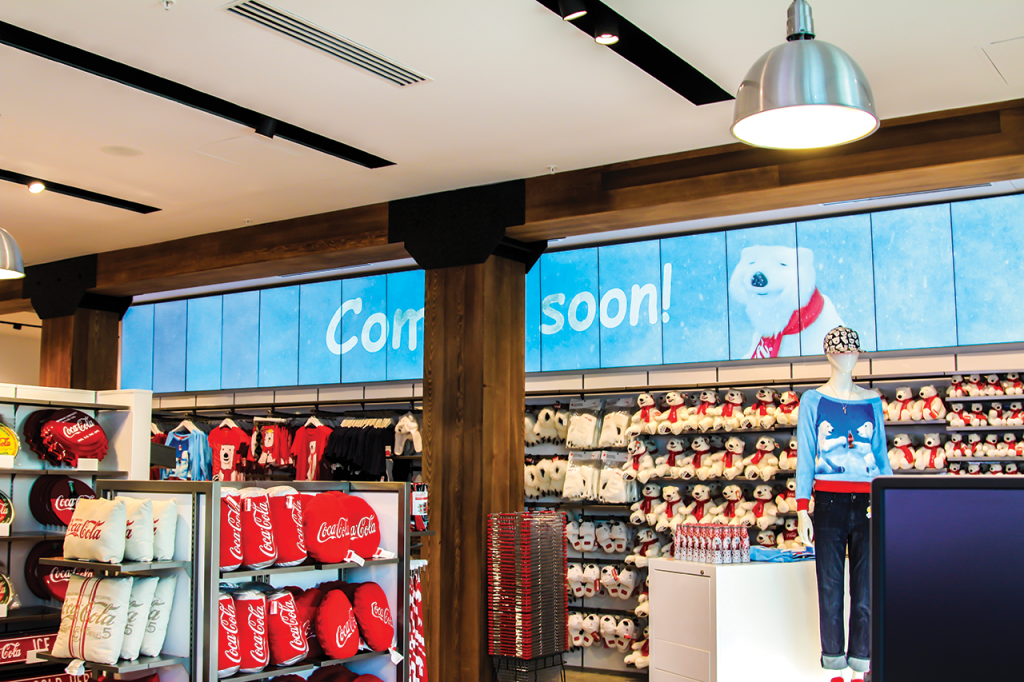Refreshment is everything at the Coca-Cola Store in Disney Springs, which is not surprising for a retail space dedicated to one of the world’s largest soft-drink manufacturers. Nearly every aspect of the Coca-Cola Store experience is geared toward that concept of refreshment, from the bevy of beverages available to taste at the rooftop bar, to the Polar Bear Experience, which uses audio, video, and lighting technology to transport visitors from the sweltering heat of Orlando FL to the arctic stomping grounds of Coca-Cola’s beloved mascot.
The Disney Springs Coca-Cola Store was a new construction, added as part of a recent large-scale renovation of Walt Disney World’s Disney Springs district (which was known as Downtown Disney until 2015). The Coca-Cola Store’s physical location is a two-story building comprised mainly of concrete and steel with a distinctly modern glass exterior. The first two floors of the building feature ample retail space where visitors can shop for a wide variety of Coca-Cola merchandise, and the second floor also hosts the aforementioned Polar Bear Experience. The building is crowned by the rooftop beverage bar. A concrete ramp located between the building frame and the glass exterior allows visitors to walk from floor to floor.
AVL tech is an essential component of the modern retail experience, and the Coca-Cola Company had some ambitious plans for the Coca-Cola store in Disney Springs, so the company reached out to Ford AV in the early phases of the building’s construction. The Ford AV team on the project consisted of Senior Account Manager Michael Burton, who was involved in the project from the planning stages and was responsible for programming audio, lighting and show-control for the Polar Bear Experience; Michael Jarnigan, the Lead Engineer during the design stages of the project; Eric Schultz, the Lead Engineer during the implementation portion of the project; Vance Barber and Aaron Roberts, who led the install team; and Project Manager Randy Robbins, who lent his years of Las Vegas entertainment-venue experience to the job.
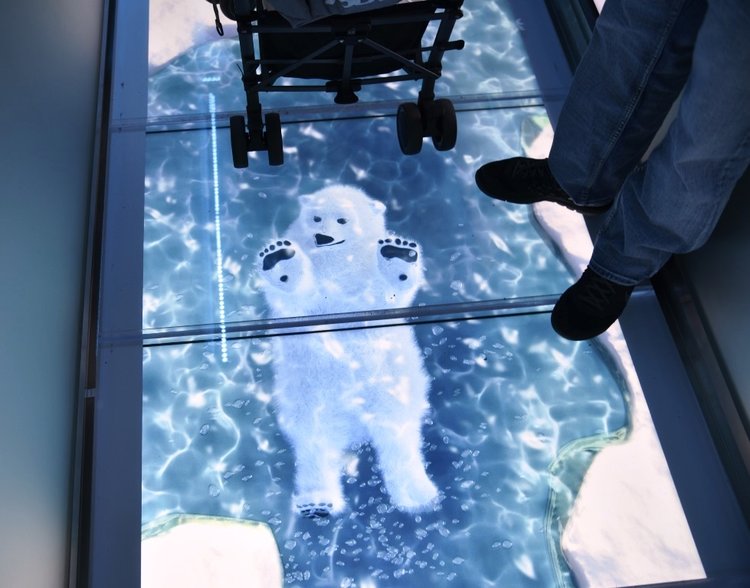
“When we were designing the store experience, we wanted to make sure that the energy level was appropriate so that people could just have a good time,” Patrick Kells, Coca-Cola’s Director of Retail Merchandising at the time of this project, said. “We are the Coca-Cola Company, and we want to immerse people in our environment. We want them to stop for a minute, pause, relax, shop, and just, you know, put their phones down for a second and enjoy themselves.” He continued, “When we’re designing a store experience, we bring a lot of people in to help us out and think through it. They help us create some ideas through a whiteboard session, and that whiteboard session then gets refined, and then we articulate ‘Well, what is the Polar Bear Experience going to be in Orlando?’, for example. And so, that is when we brought in Ford AV to bring that to life.”
“We had worked with Coca-Cola retail in their Las Vegas store, and also a couple of projects in Atlanta at the World of Coke and also some mobile projects for Coca-Cola retail,” Burton recalled. “I had met with Patrick Kells, and he had mentioned this project coming up. We suggested that they work with us as a design-build rather than waiting until everything got done and then trying to figure out how to [address the AVL systems]. They engaged us early, and we were able to be part of the design team. They also had a design company—IDL Worldwide—so Ford met with Coke and IDL to ideate and conceptualize what they were envisioning and how we could make that work with technology.”
The Coca-Cola Company’s main priorities as far as technology was concerned were creating a memorable interactive attraction for the Polar Bear Experience, as well as facilitating the use of distributed audio and video signals throughout the space. More broadly, the company also wanted to highlight its environmental sustainability efforts through a variety of art installations and informational exhibits located throughout the store, as well as through the use of reclaimed materials in the building’s construction.
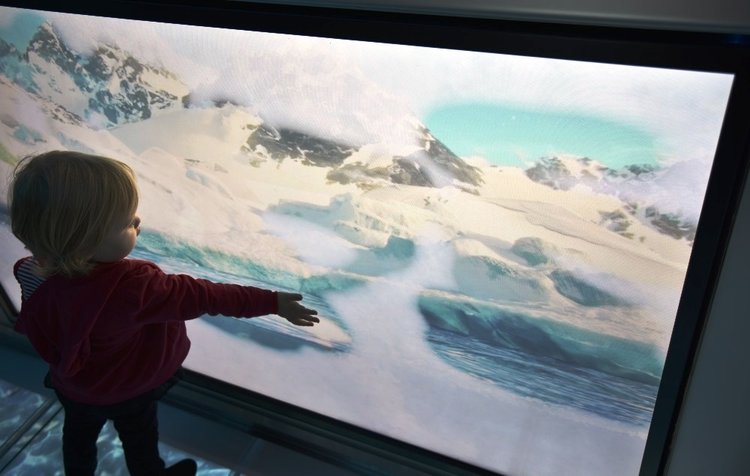
By far, the most complicated piece of the design was the Polar Bear Experience, which was conceived as a theatrical experience that would bring the habitat of the Coca-Cola polar bear to life. “They wanted the guests to be able to interact with the polar bear, which is something they had done in the past in their Vegas store and in Atlanta at the World of Coke, but this is the first time they tried to really make it feel like more of a show and be more theatrical about it, so we helped envision that,” Burton said.
The theatricality of the Polar Bear Experience begins from the moment a guest steps up to the queue. An 18×1 ribbon wall comprised of Planar Clarity Matrix MX46HDU-P displays in portrait orientation features a video of the polar bear welcoming visitors into his habitat, and the floor of the area where visitors line up for entry is actually made up of 14 Planar Clarity Matrix MX46HDU-V displays (Ford AV provided 15 total screens; one is used as a spare). The floor screens set the mood for the Polar Bear Experience by showing a fun and inviting scene of animals frolicking in the arctic. “When you walk through the door, you don’t know that you’re in a queue because you’re walking on a video platform that has the bears and the puffins swimming underneath you in an arctic environment,” Kells described.
Both the ribbon wall and the videowall on the floor use Planar Clarity Matrix G2 quad videowall controllers. There are a total of eight Alcorn McBride A/V Binloop HD players feeding content to all of the various displays in the store, including the videowalls; all of the binloop players are equipped with REPROHD2 cards.
The Polar Bear Experience also boasts some interactive exhibits that encourage customers to engage with the space while they wait for the show to start. “For the kids, as you turn the corner, we have a wipe screen that’s interactive, and when they wipe away the frost, you can look behind and see the polar bears playing in the arctic,” Kells said. The interactive wipe screen is a Planar UltraLux Touch LUX70-ERO-B-T interactive touchscreen. “A custom computer provided by IDL, who made the content, has an input from the binloop player for the background [visuals], and the computer creates the frost overlay that can be interactively wiped away,” Burton explained. In addition, a pair of Samsung DM75E displays was used to create an interactive trivia game for guests waiting in line.
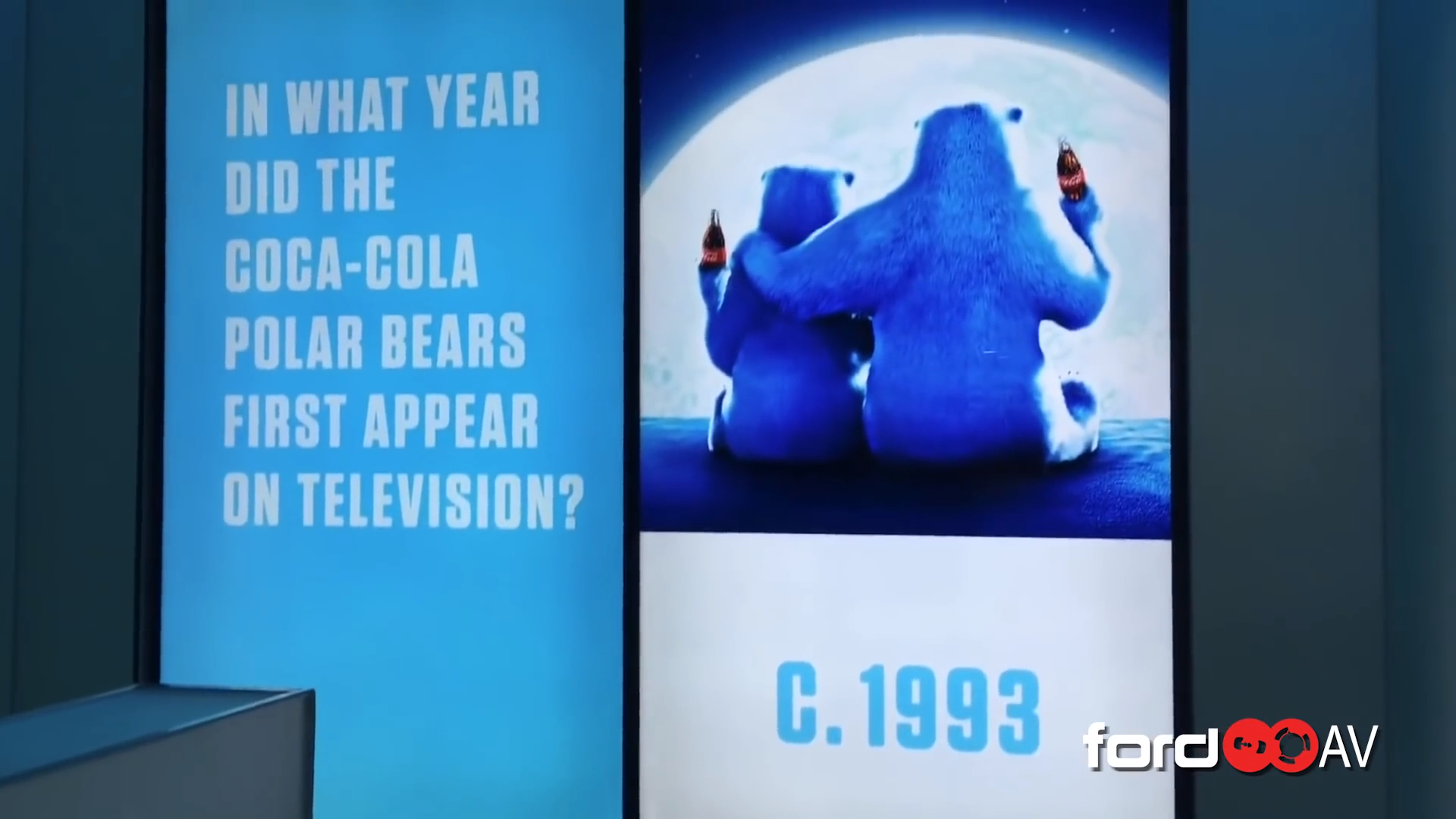
IDL and Ford AV were each responsible for creating audio content for the Polar Bear Experience area. “IDL provided the general sound effects, and we provided the music,” Burton explained. “There were multiple tracks. So, there’s a track of general ambient noise that’s kind of like you’re in a cold area or a cave in the Arctic region with wind and stuff. That plays all the time. And then there are synced effects, like the splashes as you see the polar bears dive in the water and swim around you, for example.” An Alcorn McBride ProTraXX 16-channel audio repeater plays the audio content, while a pair of Alcorn McBride V16 Pro show controllers keeps all the content synced. (According to Burton, J.R. Solis and the team at Alcorn McBride were instrumental in making the Polar Bear Experience a reality.) Burton composed the music for the Polar Bear Experience show himself using Apple Logic.
The actual Polar Bear Experience show takes place multiple times a day at timed intervals. The concept of the show is to give visitors a chance to personally interact with the beloved Coca-Cola mascot. Visitors are encouraged to pose for pictures with the polar bear to post on their social media, and a photographer employed by the store also takes professional shots of guests interacting with the polar bear. A Reflecmedia Chromatte projection screen installed in the Polar Bear Experience area allows the photographer to apply chroma-key effects to the photos in post production.
At the beginning of each show, the Coca-Cola polar bear himself makes a flashy entrance. “The entrance and the exit of the polar bear is kind of a cool thing. It’s got music, lighting, haze and everything working together,” Burton described. “The lights go down, the floor darkens, [the videowalls and touchscreens] actually freeze over, fog comes up, and then the polar bear comes out. We helped conceptualize how to do that and how to make all the parts work. IDL made the content for the video, and then we created the audio content, as well as programmed the lighting show and all the show-control elements.”
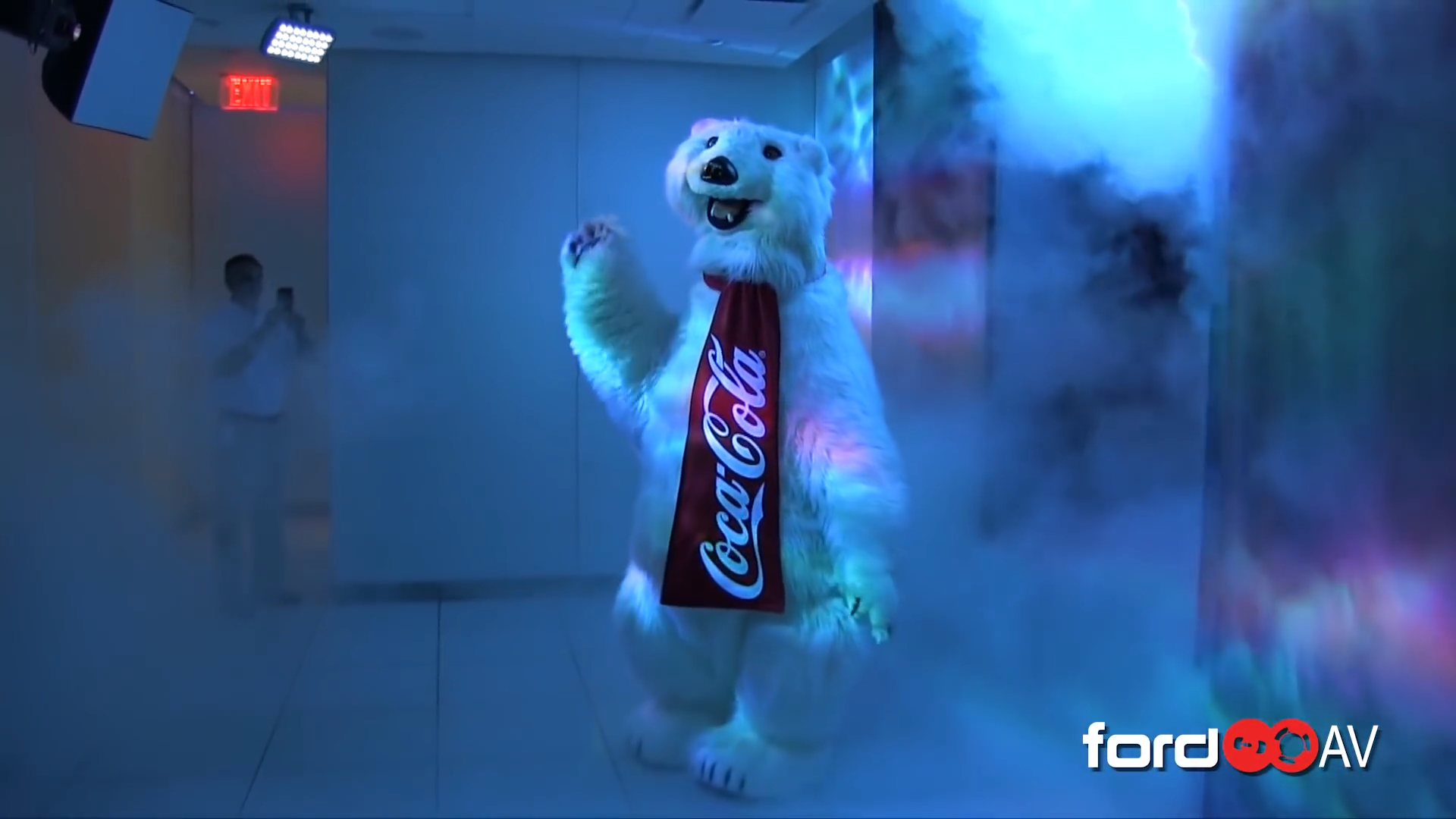
To ensure that the polar bear’s entrance was sufficiently impactful, Ford AV devised a way to make it seem as if he materializes out of an Aurora Borealis effect. You’re probably thinking… Aurora Borealis!? At any time of year, at any time of day, in this part of the country, localized entirely within the Disney Springs Coca-Cola Store!? Well, it’s true, and Ford AV pulled it off using fog, a pair of Rosco Laboratories X24 X-Effects projectors and the Chromatte screen. “The fog was created with a custom LN2 system that was owner provided and is part of the show-control system. And the Rosco projectors, they have a lens gobo recipe to make the Aurora Borealis effect, and we use that on the grey screen with the haze to create that effect.” Kells added, “The Aurora Borealis starts on the fog, the music changes, and there’s a big ta-da!
Theatrical lighting in the Polar Bear Experience is provided by a total of six Martin Lighting Tripix wash fixtures. In addition, a number of Martin Lighting fixtures are used for cove lighting throughout the Polar Bear Experience space. An Alcorn McBride LightCue DMX recorder handles the lighting presets, which were programmed using Jands Vista 2 (AKA Byron) software. All of the show control elements are tied into the Crestron control system, so the end user can operate the same interface for the Polar Bear Experience, as well as the general audio and video throughout the rest of the building. Ford AV can also control some aspects of the Polar Bear Experience, such as show cues, remotely via a Dell OptiPlex 9020M computer.
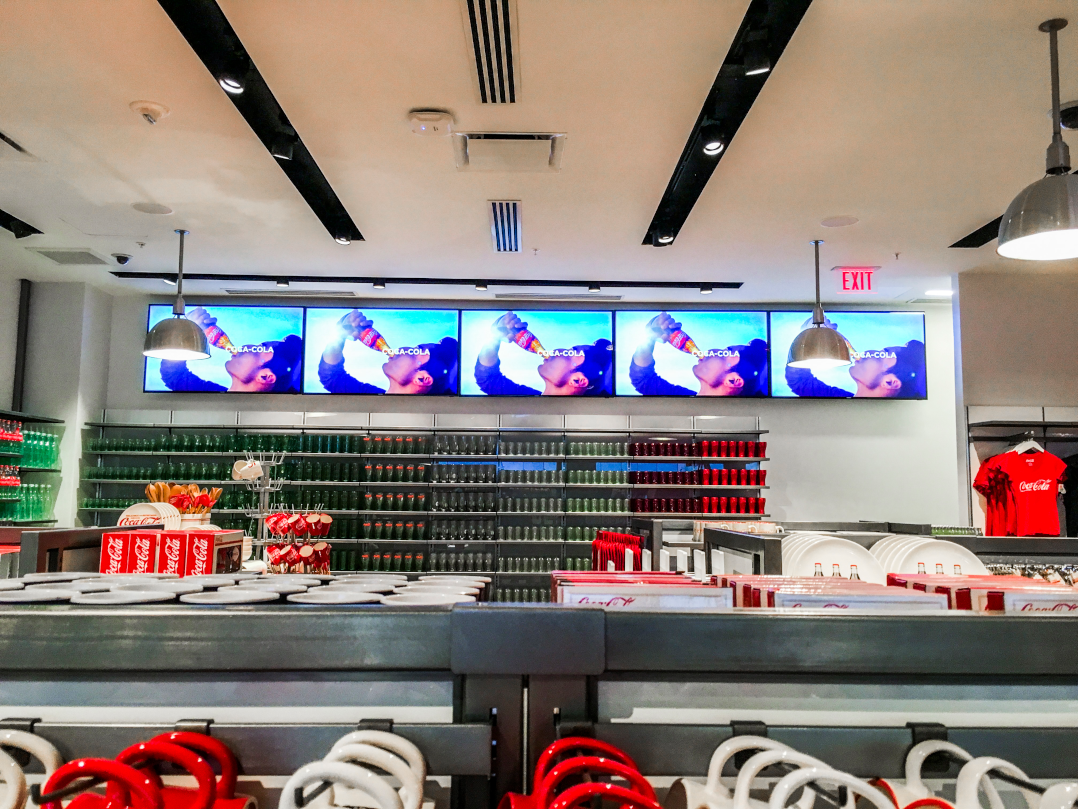
Outside of the Polar Bear Experience, the Disney Springs Coca-Cola Store leverages music and video in a variety of ways to keep customers engaged. “Coke has their own curated music video channels, which includes their own Coke commercial content, so they wanted pretty much every direction you look for you to be able to see a screen and see those videos,” Burton explained. Fourteen Samsung DM65E and two Samsung DM75E displays are located throughout the retail area on the first floor.
The distributed video signals run on an HD/RF modulated video system that was built using Thor Broadcast modulators. “Right now, they’re only using one channel, and then they have a backup channel if for some reason the main channel isn’t working,” Burton said. “Both of those channels are showing the same content from two different players from Mood Media. If they ever want to add something else or display content on different displays, they can easily do that without having to change any of the infrastructure.”
A distributed audio system plays content throughout the interior of the building, as well as the ramps located between the outer wall and the glass exterior. Each different area of the store has its own volume control. “Regarding audio, we set it up to where, especially on different floors, if they wanted different volume levels they could do that,” Burton explained. “Everything was normalized so that 50 percent in one area is going to sound like 50 percent in another area. But depending on the crowd they have and what’s going on, if they want to bump up an area or two they can do it. Most of the time they don’t, but it gives them that flexibility. And we also have it set up where they can select all of the zones at once and just turn them all to the same volume. They don’t have to do one at a time if they don’t want to.”

Audio content is played through 24 Tannoy AMS 8DC surface-mount speakers and 66 Tannoy CMS 503ICT LP ceiling speakers, which were installed both inside the venue and on the exterior concrete ramp as needed. Low-end audio support is provided by nine Tannoy 110SR-70V60W sheetrock subs and a Tannoy 110TB-70V60W ceiling-mounted sub. A variety of Crown and Stewart Audio amplifiers are in use throughout the space, and two BSS Audio BLU-100s handle signal processing.
Distributed audio and video are controlled via a Crestron control system. Managers can interface with the system via Crestron touchscreens located on each floor, or through iPad control.
The final attraction at the Disney Springs Coca-Cola Store is the rooftop beverage bar, where visitors can sample a wide variety of Coca-Cola flavors. The bar area features a digital menu board made up of nine Planar Clarity Matrix MX55HDU-P digital signage displays. Music is played over 18 total Tannoy AMS 5ICT outdoor speakers; these are flown in groups of four from support columns spread throughout the bar area. The bar also features a Shure QLXD24/B58-G50 wireless mic system, which is used for special events where a mic input is required, as well as for internal staff meetings.
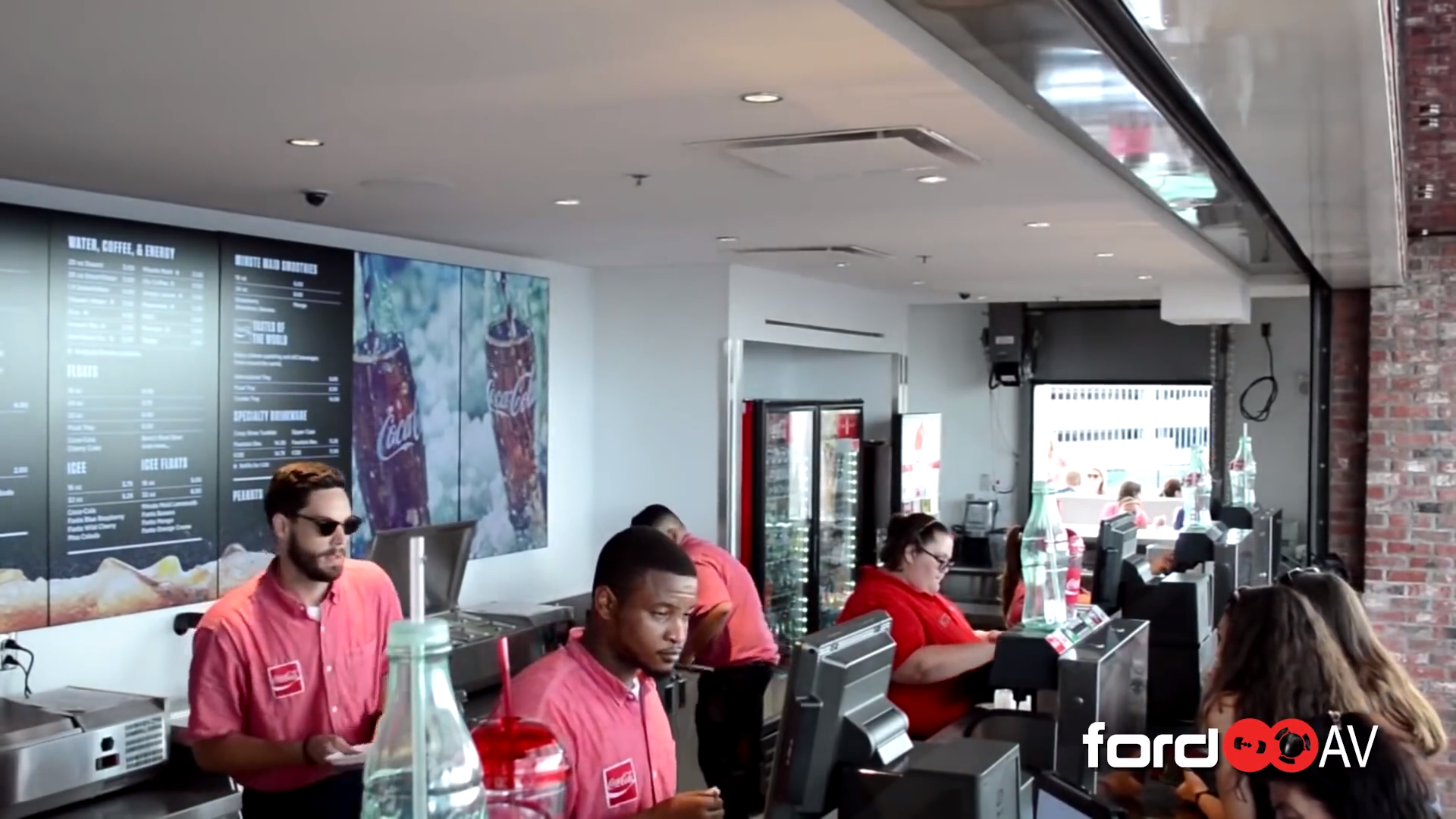
Although the system is designed to run with minimal input from store staff, Ford AV is on call to address any problems that may arise with the system and to provide remote troubleshooting. “We have a service contract to go out there and support them as needed,” Burton said. “They do have some staff that are more technically proficient, and we’ve helped train them on how to deal with issues and reboot things or change things, but we tried as much as possible to design the systems to pretty much run themselves unless there’s a problem.”
All told, the finished project seems to have successfully met all of the Coca-Cola Company’s expectations for the Disney Springs store. “Our main objective was making sure that people had a great experience. It wasn’t just a retail store,” Kells said. “So, how we know we’re successful is when [customers are] immediately picking up their phone and posting it, and wanting to tell people and wanting to invite people to come and experience what they’ve experienced, because it was so great for them. That, for us, is a job well done.”
And the project was rewardingfrom Ford AV’s perspective, as well. “This was a tremendous opportunity to be involved in a project from concept to creation at Disney Springs, and helping Coca-Cola and IDL transform their initial vision from imagination to reality was a fantastic experience,” Burton enthused.
